Business Law Report: Qantas, Airbus, and Contractual Issues
VerifiedAdded on 2019/11/08
|10
|2364
|54
Report
AI Summary
This report delves into two key areas of business law: exclusion clauses and vicarious liability, illustrated through case studies. The first part analyzes a contract dispute between Qantas Airlines and Airbus Corporation Limited, focusing on the application of exclusion clauses. It examines whether the exclusion clause can be applied in this case. The analysis considers the formation of a contract, including offer, acceptance, and the legal implications of additional terms and misrepresentation. The second part explores vicarious liability, using a scenario involving a salesperson and an employee's actions. It discusses the principle of agency, misrepresentation of facts, and the potential liabilities of the principal for the agent's actions. The report concludes with an assessment of liability under both scenarios, considering the application of relevant case law and legal principles. The report provides a detailed examination of contract law principles, vicarious liability, and their practical implications in business settings. This report is available on Desklib, a platform providing AI-based study tools.
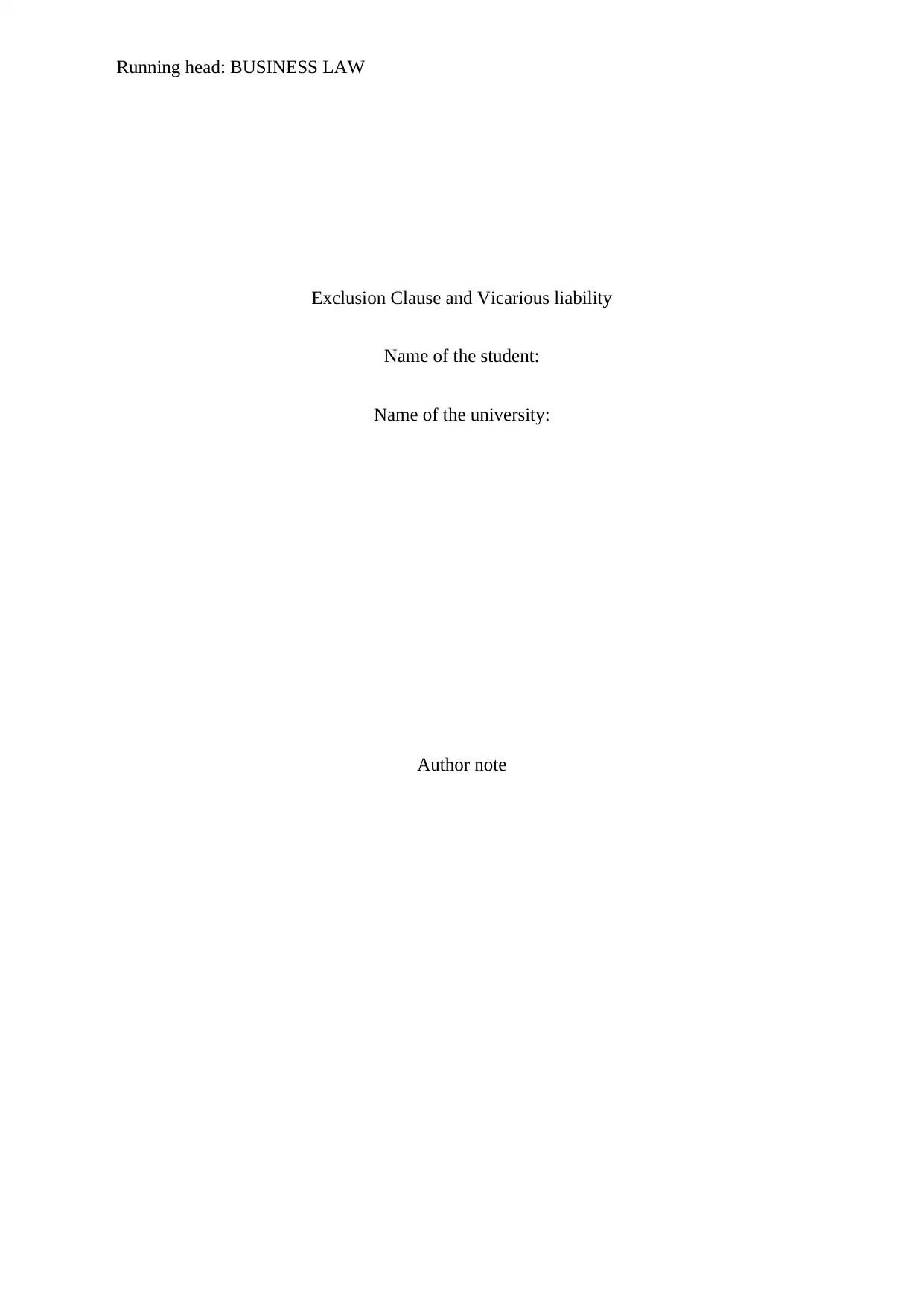
Running head: BUSINESS LAW
Exclusion Clause and Vicarious liability
Name of the student:
Name of the university:
Author note
Exclusion Clause and Vicarious liability
Name of the student:
Name of the university:
Author note
Paraphrase This Document
Need a fresh take? Get an instant paraphrase of this document with our AI Paraphraser
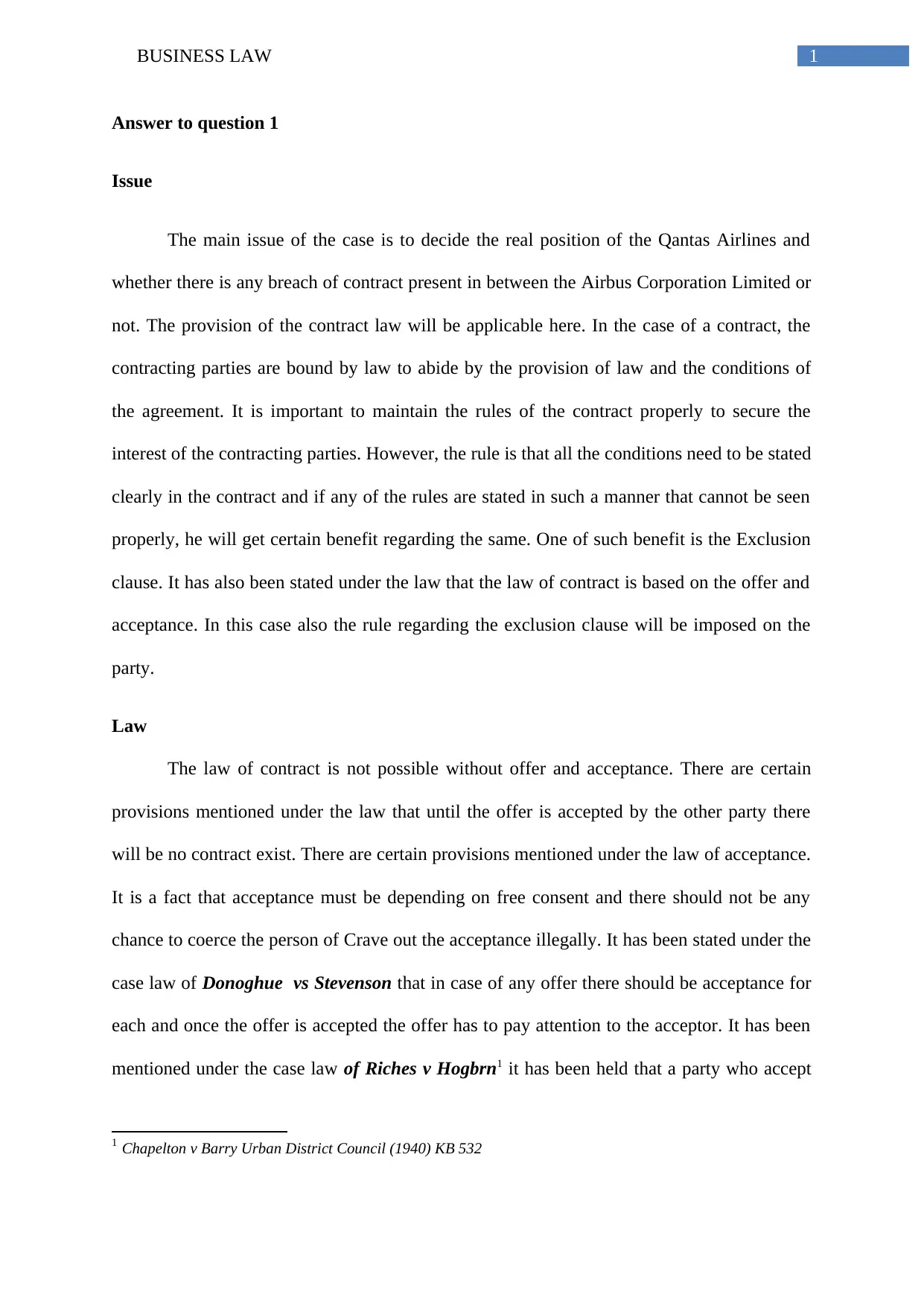
1BUSINESS LAW
Answer to question 1
Issue
The main issue of the case is to decide the real position of the Qantas Airlines and
whether there is any breach of contract present in between the Airbus Corporation Limited or
not. The provision of the contract law will be applicable here. In the case of a contract, the
contracting parties are bound by law to abide by the provision of law and the conditions of
the agreement. It is important to maintain the rules of the contract properly to secure the
interest of the contracting parties. However, the rule is that all the conditions need to be stated
clearly in the contract and if any of the rules are stated in such a manner that cannot be seen
properly, he will get certain benefit regarding the same. One of such benefit is the Exclusion
clause. It has also been stated under the law that the law of contract is based on the offer and
acceptance. In this case also the rule regarding the exclusion clause will be imposed on the
party.
Law
The law of contract is not possible without offer and acceptance. There are certain
provisions mentioned under the law that until the offer is accepted by the other party there
will be no contract exist. There are certain provisions mentioned under the law of acceptance.
It is a fact that acceptance must be depending on free consent and there should not be any
chance to coerce the person of Crave out the acceptance illegally. It has been stated under the
case law of Donoghue vs Stevenson that in case of any offer there should be acceptance for
each and once the offer is accepted the offer has to pay attention to the acceptor. It has been
mentioned under the case law of Riches v Hogbrn1 it has been held that a party who accept
1 Chapelton v Barry Urban District Council (1940) KB 532
Answer to question 1
Issue
The main issue of the case is to decide the real position of the Qantas Airlines and
whether there is any breach of contract present in between the Airbus Corporation Limited or
not. The provision of the contract law will be applicable here. In the case of a contract, the
contracting parties are bound by law to abide by the provision of law and the conditions of
the agreement. It is important to maintain the rules of the contract properly to secure the
interest of the contracting parties. However, the rule is that all the conditions need to be stated
clearly in the contract and if any of the rules are stated in such a manner that cannot be seen
properly, he will get certain benefit regarding the same. One of such benefit is the Exclusion
clause. It has also been stated under the law that the law of contract is based on the offer and
acceptance. In this case also the rule regarding the exclusion clause will be imposed on the
party.
Law
The law of contract is not possible without offer and acceptance. There are certain
provisions mentioned under the law that until the offer is accepted by the other party there
will be no contract exist. There are certain provisions mentioned under the law of acceptance.
It is a fact that acceptance must be depending on free consent and there should not be any
chance to coerce the person of Crave out the acceptance illegally. It has been stated under the
case law of Donoghue vs Stevenson that in case of any offer there should be acceptance for
each and once the offer is accepted the offer has to pay attention to the acceptor. It has been
mentioned under the case law of Riches v Hogbrn1 it has been held that a party who accept
1 Chapelton v Barry Urban District Council (1940) KB 532
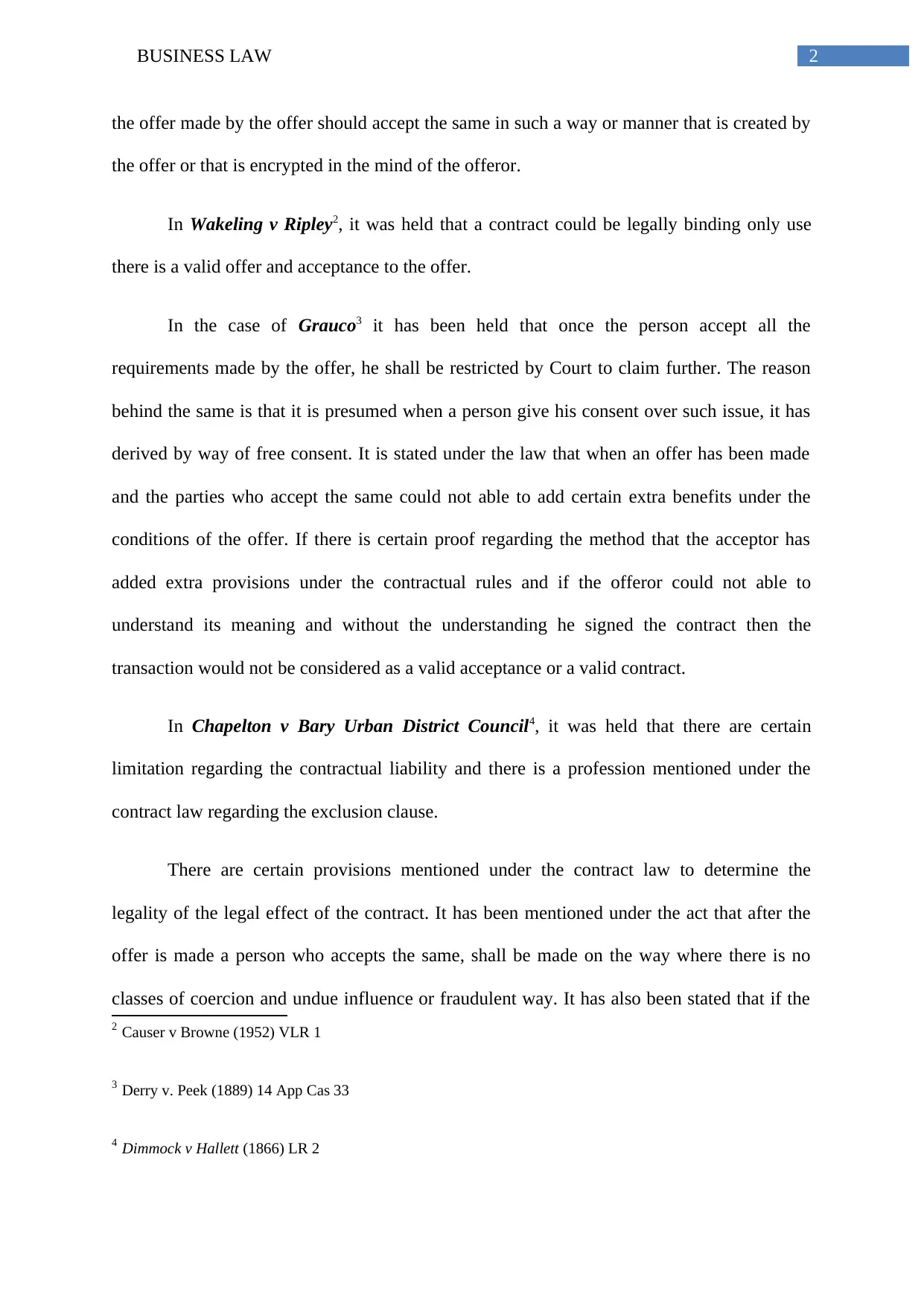
2BUSINESS LAW
the offer made by the offer should accept the same in such a way or manner that is created by
the offer or that is encrypted in the mind of the offeror.
In Wakeling v Ripley2, it was held that a contract could be legally binding only use
there is a valid offer and acceptance to the offer.
In the case of Grauco3 it has been held that once the person accept all the
requirements made by the offer, he shall be restricted by Court to claim further. The reason
behind the same is that it is presumed when a person give his consent over such issue, it has
derived by way of free consent. It is stated under the law that when an offer has been made
and the parties who accept the same could not able to add certain extra benefits under the
conditions of the offer. If there is certain proof regarding the method that the acceptor has
added extra provisions under the contractual rules and if the offeror could not able to
understand its meaning and without the understanding he signed the contract then the
transaction would not be considered as a valid acceptance or a valid contract.
In Chapelton v Bary Urban District Council4, it was held that there are certain
limitation regarding the contractual liability and there is a profession mentioned under the
contract law regarding the exclusion clause.
There are certain provisions mentioned under the contract law to determine the
legality of the legal effect of the contract. It has been mentioned under the act that after the
offer is made a person who accepts the same, shall be made on the way where there is no
classes of coercion and undue influence or fraudulent way. It has also been stated that if the
2 Causer v Browne (1952) VLR 1
3 Derry v. Peek (1889) 14 App Cas 33
4 Dimmock v Hallett (1866) LR 2
the offer made by the offer should accept the same in such a way or manner that is created by
the offer or that is encrypted in the mind of the offeror.
In Wakeling v Ripley2, it was held that a contract could be legally binding only use
there is a valid offer and acceptance to the offer.
In the case of Grauco3 it has been held that once the person accept all the
requirements made by the offer, he shall be restricted by Court to claim further. The reason
behind the same is that it is presumed when a person give his consent over such issue, it has
derived by way of free consent. It is stated under the law that when an offer has been made
and the parties who accept the same could not able to add certain extra benefits under the
conditions of the offer. If there is certain proof regarding the method that the acceptor has
added extra provisions under the contractual rules and if the offeror could not able to
understand its meaning and without the understanding he signed the contract then the
transaction would not be considered as a valid acceptance or a valid contract.
In Chapelton v Bary Urban District Council4, it was held that there are certain
limitation regarding the contractual liability and there is a profession mentioned under the
contract law regarding the exclusion clause.
There are certain provisions mentioned under the contract law to determine the
legality of the legal effect of the contract. It has been mentioned under the act that after the
offer is made a person who accepts the same, shall be made on the way where there is no
classes of coercion and undue influence or fraudulent way. It has also been stated that if the
2 Causer v Browne (1952) VLR 1
3 Derry v. Peek (1889) 14 App Cas 33
4 Dimmock v Hallett (1866) LR 2
⊘ This is a preview!⊘
Do you want full access?
Subscribe today to unlock all pages.

Trusted by 1+ million students worldwide
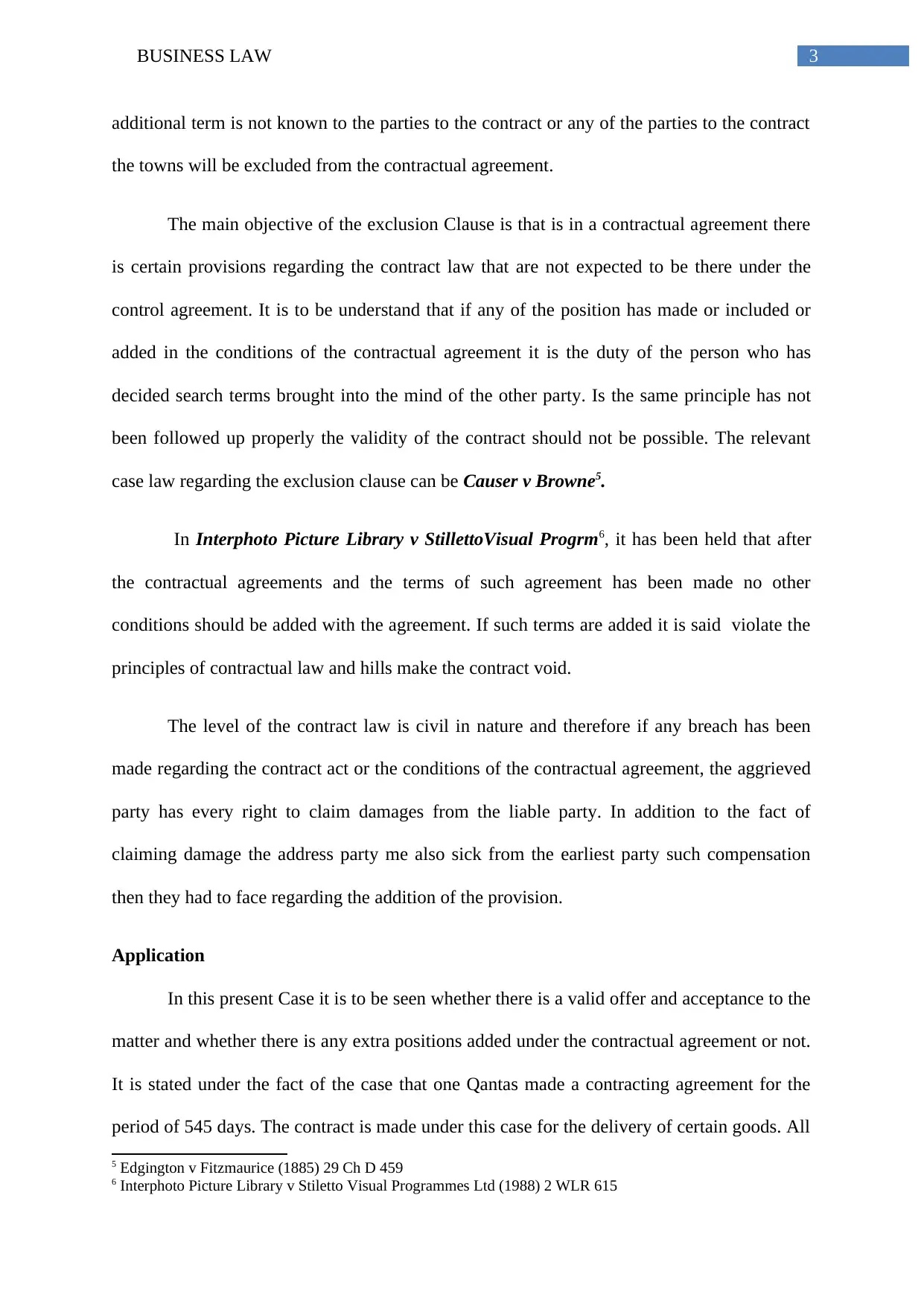
3BUSINESS LAW
additional term is not known to the parties to the contract or any of the parties to the contract
the towns will be excluded from the contractual agreement.
The main objective of the exclusion Clause is that is in a contractual agreement there
is certain provisions regarding the contract law that are not expected to be there under the
control agreement. It is to be understand that if any of the position has made or included or
added in the conditions of the contractual agreement it is the duty of the person who has
decided search terms brought into the mind of the other party. Is the same principle has not
been followed up properly the validity of the contract should not be possible. The relevant
case law regarding the exclusion clause can be Causer v Browne5.
In Interphoto Picture Library v StillettoVisual Progrm6, it has been held that after
the contractual agreements and the terms of such agreement has been made no other
conditions should be added with the agreement. If such terms are added it is said violate the
principles of contractual law and hills make the contract void.
The level of the contract law is civil in nature and therefore if any breach has been
made regarding the contract act or the conditions of the contractual agreement, the aggrieved
party has every right to claim damages from the liable party. In addition to the fact of
claiming damage the address party me also sick from the earliest party such compensation
then they had to face regarding the addition of the provision.
Application
In this present Case it is to be seen whether there is a valid offer and acceptance to the
matter and whether there is any extra positions added under the contractual agreement or not.
It is stated under the fact of the case that one Qantas made a contracting agreement for the
period of 545 days. The contract is made under this case for the delivery of certain goods. All
5 Edgington v Fitzmaurice (1885) 29 Ch D 459
6 Interphoto Picture Library v Stiletto Visual Programmes Ltd (1988) 2 WLR 615
additional term is not known to the parties to the contract or any of the parties to the contract
the towns will be excluded from the contractual agreement.
The main objective of the exclusion Clause is that is in a contractual agreement there
is certain provisions regarding the contract law that are not expected to be there under the
control agreement. It is to be understand that if any of the position has made or included or
added in the conditions of the contractual agreement it is the duty of the person who has
decided search terms brought into the mind of the other party. Is the same principle has not
been followed up properly the validity of the contract should not be possible. The relevant
case law regarding the exclusion clause can be Causer v Browne5.
In Interphoto Picture Library v StillettoVisual Progrm6, it has been held that after
the contractual agreements and the terms of such agreement has been made no other
conditions should be added with the agreement. If such terms are added it is said violate the
principles of contractual law and hills make the contract void.
The level of the contract law is civil in nature and therefore if any breach has been
made regarding the contract act or the conditions of the contractual agreement, the aggrieved
party has every right to claim damages from the liable party. In addition to the fact of
claiming damage the address party me also sick from the earliest party such compensation
then they had to face regarding the addition of the provision.
Application
In this present Case it is to be seen whether there is a valid offer and acceptance to the
matter and whether there is any extra positions added under the contractual agreement or not.
It is stated under the fact of the case that one Qantas made a contracting agreement for the
period of 545 days. The contract is made under this case for the delivery of certain goods. All
5 Edgington v Fitzmaurice (1885) 29 Ch D 459
6 Interphoto Picture Library v Stiletto Visual Programmes Ltd (1988) 2 WLR 615
Paraphrase This Document
Need a fresh take? Get an instant paraphrase of this document with our AI Paraphraser
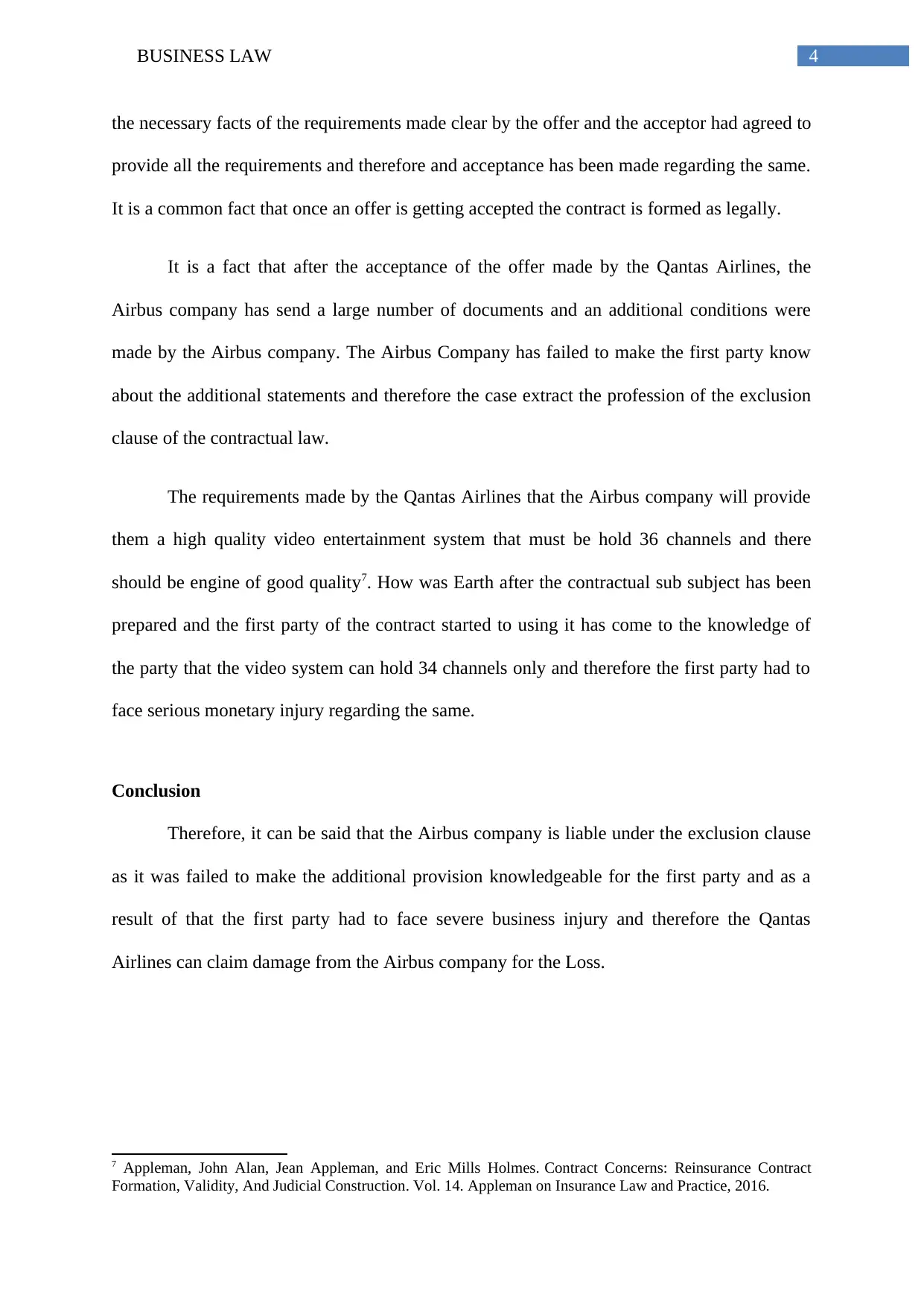
4BUSINESS LAW
the necessary facts of the requirements made clear by the offer and the acceptor had agreed to
provide all the requirements and therefore and acceptance has been made regarding the same.
It is a common fact that once an offer is getting accepted the contract is formed as legally.
It is a fact that after the acceptance of the offer made by the Qantas Airlines, the
Airbus company has send a large number of documents and an additional conditions were
made by the Airbus company. The Airbus Company has failed to make the first party know
about the additional statements and therefore the case extract the profession of the exclusion
clause of the contractual law.
The requirements made by the Qantas Airlines that the Airbus company will provide
them a high quality video entertainment system that must be hold 36 channels and there
should be engine of good quality7. How was Earth after the contractual sub subject has been
prepared and the first party of the contract started to using it has come to the knowledge of
the party that the video system can hold 34 channels only and therefore the first party had to
face serious monetary injury regarding the same.
Conclusion
Therefore, it can be said that the Airbus company is liable under the exclusion clause
as it was failed to make the additional provision knowledgeable for the first party and as a
result of that the first party had to face severe business injury and therefore the Qantas
Airlines can claim damage from the Airbus company for the Loss.
7 Appleman, John Alan, Jean Appleman, and Eric Mills Holmes. Contract Concerns: Reinsurance Contract
Formation, Validity, And Judicial Construction. Vol. 14. Appleman on Insurance Law and Practice, 2016.
the necessary facts of the requirements made clear by the offer and the acceptor had agreed to
provide all the requirements and therefore and acceptance has been made regarding the same.
It is a common fact that once an offer is getting accepted the contract is formed as legally.
It is a fact that after the acceptance of the offer made by the Qantas Airlines, the
Airbus company has send a large number of documents and an additional conditions were
made by the Airbus company. The Airbus Company has failed to make the first party know
about the additional statements and therefore the case extract the profession of the exclusion
clause of the contractual law.
The requirements made by the Qantas Airlines that the Airbus company will provide
them a high quality video entertainment system that must be hold 36 channels and there
should be engine of good quality7. How was Earth after the contractual sub subject has been
prepared and the first party of the contract started to using it has come to the knowledge of
the party that the video system can hold 34 channels only and therefore the first party had to
face serious monetary injury regarding the same.
Conclusion
Therefore, it can be said that the Airbus company is liable under the exclusion clause
as it was failed to make the additional provision knowledgeable for the first party and as a
result of that the first party had to face severe business injury and therefore the Qantas
Airlines can claim damage from the Airbus company for the Loss.
7 Appleman, John Alan, Jean Appleman, and Eric Mills Holmes. Contract Concerns: Reinsurance Contract
Formation, Validity, And Judicial Construction. Vol. 14. Appleman on Insurance Law and Practice, 2016.
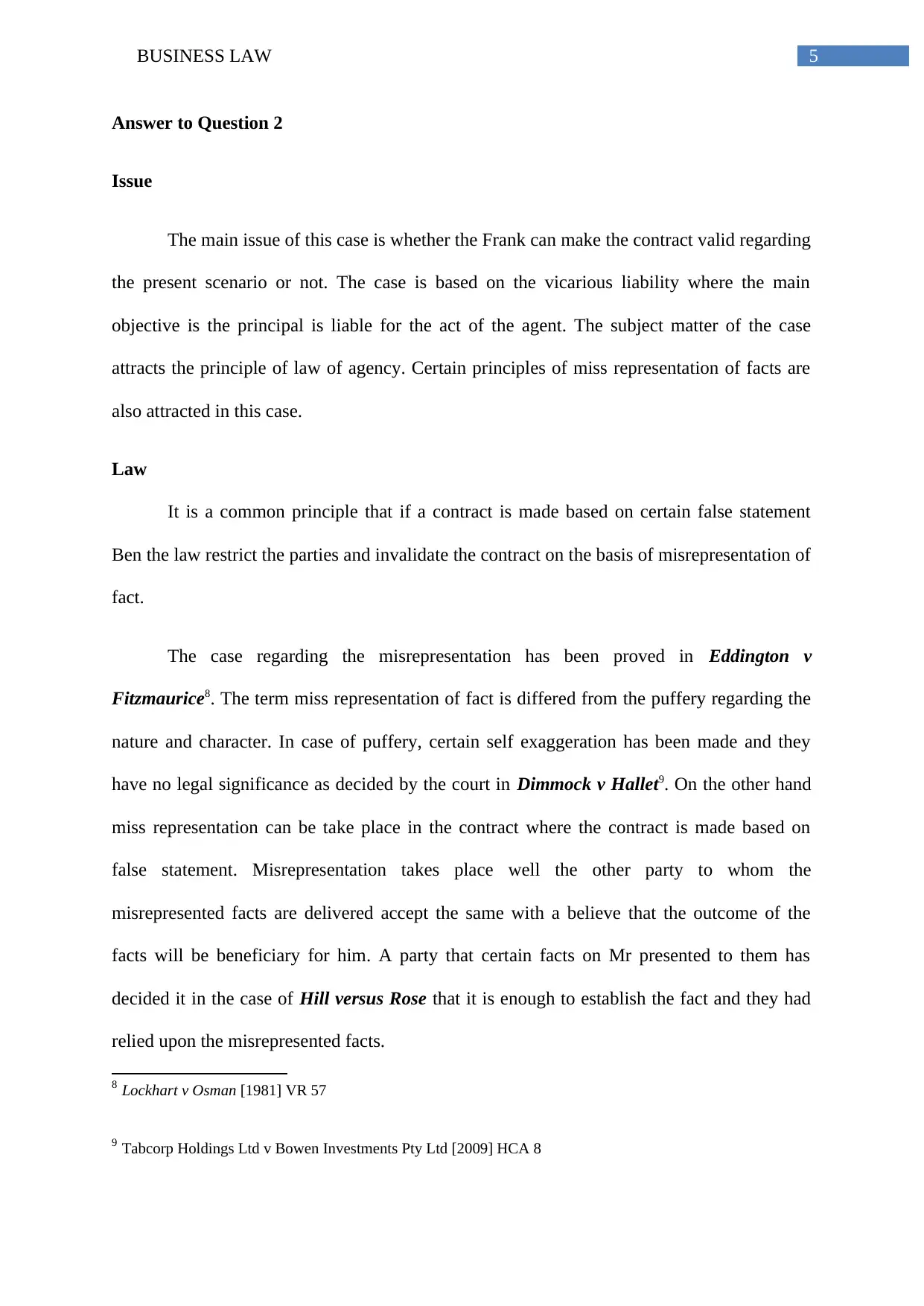
5BUSINESS LAW
Answer to Question 2
Issue
The main issue of this case is whether the Frank can make the contract valid regarding
the present scenario or not. The case is based on the vicarious liability where the main
objective is the principal is liable for the act of the agent. The subject matter of the case
attracts the principle of law of agency. Certain principles of miss representation of facts are
also attracted in this case.
Law
It is a common principle that if a contract is made based on certain false statement
Ben the law restrict the parties and invalidate the contract on the basis of misrepresentation of
fact.
The case regarding the misrepresentation has been proved in Eddington v
Fitzmaurice8. The term miss representation of fact is differed from the puffery regarding the
nature and character. In case of puffery, certain self exaggeration has been made and they
have no legal significance as decided by the court in Dimmock v Hallet9. On the other hand
miss representation can be take place in the contract where the contract is made based on
false statement. Misrepresentation takes place well the other party to whom the
misrepresented facts are delivered accept the same with a believe that the outcome of the
facts will be beneficiary for him. A party that certain facts on Mr presented to them has
decided it in the case of Hill versus Rose that it is enough to establish the fact and they had
relied upon the misrepresented facts.
8 Lockhart v Osman [1981] VR 57
9 Tabcorp Holdings Ltd v Bowen Investments Pty Ltd [2009] HCA 8
Answer to Question 2
Issue
The main issue of this case is whether the Frank can make the contract valid regarding
the present scenario or not. The case is based on the vicarious liability where the main
objective is the principal is liable for the act of the agent. The subject matter of the case
attracts the principle of law of agency. Certain principles of miss representation of facts are
also attracted in this case.
Law
It is a common principle that if a contract is made based on certain false statement
Ben the law restrict the parties and invalidate the contract on the basis of misrepresentation of
fact.
The case regarding the misrepresentation has been proved in Eddington v
Fitzmaurice8. The term miss representation of fact is differed from the puffery regarding the
nature and character. In case of puffery, certain self exaggeration has been made and they
have no legal significance as decided by the court in Dimmock v Hallet9. On the other hand
miss representation can be take place in the contract where the contract is made based on
false statement. Misrepresentation takes place well the other party to whom the
misrepresented facts are delivered accept the same with a believe that the outcome of the
facts will be beneficiary for him. A party that certain facts on Mr presented to them has
decided it in the case of Hill versus Rose that it is enough to establish the fact and they had
relied upon the misrepresented facts.
8 Lockhart v Osman [1981] VR 57
9 Tabcorp Holdings Ltd v Bowen Investments Pty Ltd [2009] HCA 8
⊘ This is a preview!⊘
Do you want full access?
Subscribe today to unlock all pages.

Trusted by 1+ million students worldwide
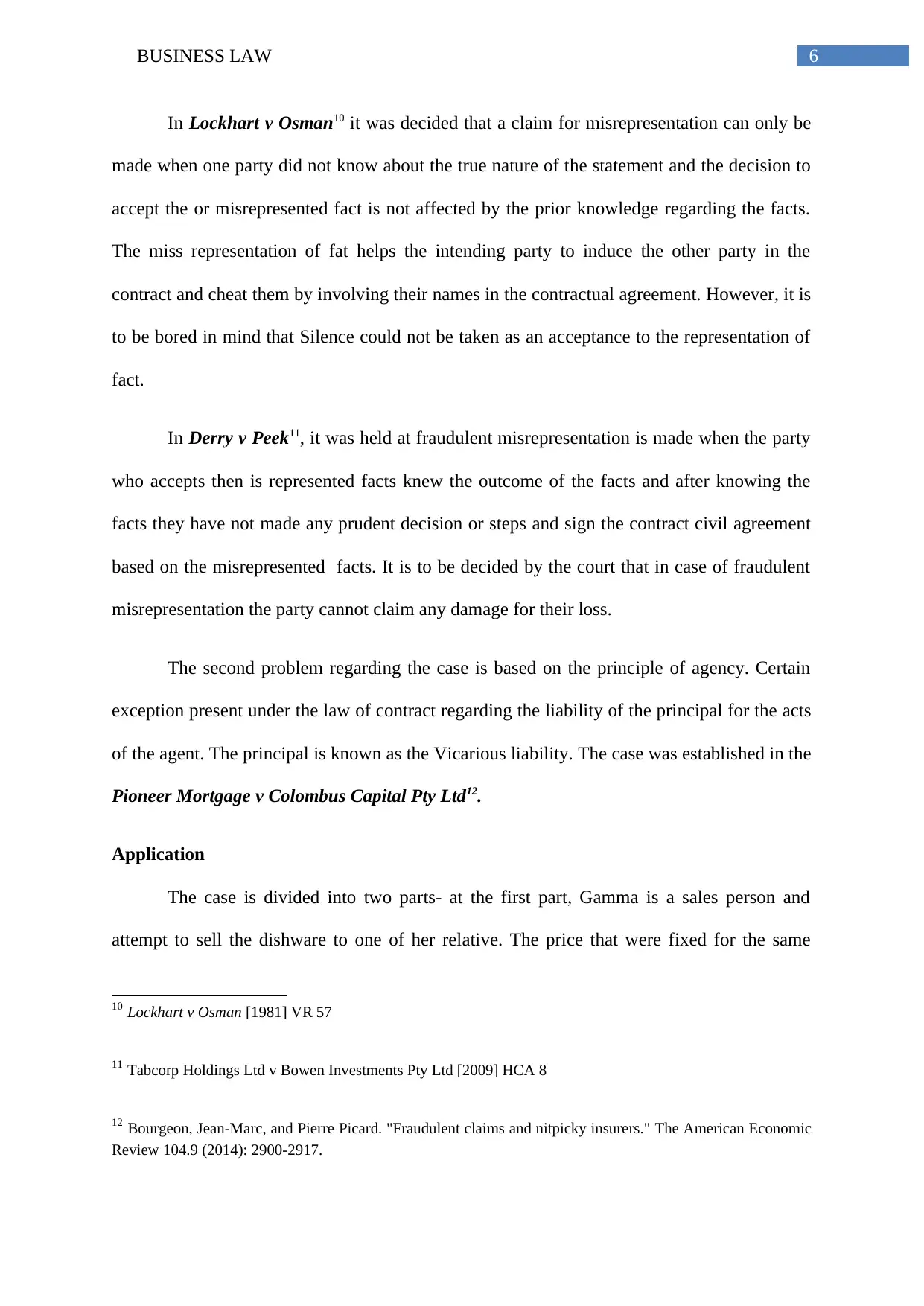
6BUSINESS LAW
In Lockhart v Osman10 it was decided that a claim for misrepresentation can only be
made when one party did not know about the true nature of the statement and the decision to
accept the or misrepresented fact is not affected by the prior knowledge regarding the facts.
The miss representation of fat helps the intending party to induce the other party in the
contract and cheat them by involving their names in the contractual agreement. However, it is
to be bored in mind that Silence could not be taken as an acceptance to the representation of
fact.
In Derry v Peek11, it was held at fraudulent misrepresentation is made when the party
who accepts then is represented facts knew the outcome of the facts and after knowing the
facts they have not made any prudent decision or steps and sign the contract civil agreement
based on the misrepresented facts. It is to be decided by the court that in case of fraudulent
misrepresentation the party cannot claim any damage for their loss.
The second problem regarding the case is based on the principle of agency. Certain
exception present under the law of contract regarding the liability of the principal for the acts
of the agent. The principal is known as the Vicarious liability. The case was established in the
Pioneer Mortgage v Colombus Capital Pty Ltd12.
Application
The case is divided into two parts- at the first part, Gamma is a sales person and
attempt to sell the dishware to one of her relative. The price that were fixed for the same
10 Lockhart v Osman [1981] VR 57
11 Tabcorp Holdings Ltd v Bowen Investments Pty Ltd [2009] HCA 8
12 Bourgeon, Jean-Marc, and Pierre Picard. "Fraudulent claims and nitpicky insurers." The American Economic
Review 104.9 (2014): 2900-2917.
In Lockhart v Osman10 it was decided that a claim for misrepresentation can only be
made when one party did not know about the true nature of the statement and the decision to
accept the or misrepresented fact is not affected by the prior knowledge regarding the facts.
The miss representation of fat helps the intending party to induce the other party in the
contract and cheat them by involving their names in the contractual agreement. However, it is
to be bored in mind that Silence could not be taken as an acceptance to the representation of
fact.
In Derry v Peek11, it was held at fraudulent misrepresentation is made when the party
who accepts then is represented facts knew the outcome of the facts and after knowing the
facts they have not made any prudent decision or steps and sign the contract civil agreement
based on the misrepresented facts. It is to be decided by the court that in case of fraudulent
misrepresentation the party cannot claim any damage for their loss.
The second problem regarding the case is based on the principle of agency. Certain
exception present under the law of contract regarding the liability of the principal for the acts
of the agent. The principal is known as the Vicarious liability. The case was established in the
Pioneer Mortgage v Colombus Capital Pty Ltd12.
Application
The case is divided into two parts- at the first part, Gamma is a sales person and
attempt to sell the dishware to one of her relative. The price that were fixed for the same
10 Lockhart v Osman [1981] VR 57
11 Tabcorp Holdings Ltd v Bowen Investments Pty Ltd [2009] HCA 8
12 Bourgeon, Jean-Marc, and Pierre Picard. "Fraudulent claims and nitpicky insurers." The American Economic
Review 104.9 (2014): 2900-2917.
Paraphrase This Document
Need a fresh take? Get an instant paraphrase of this document with our AI Paraphraser
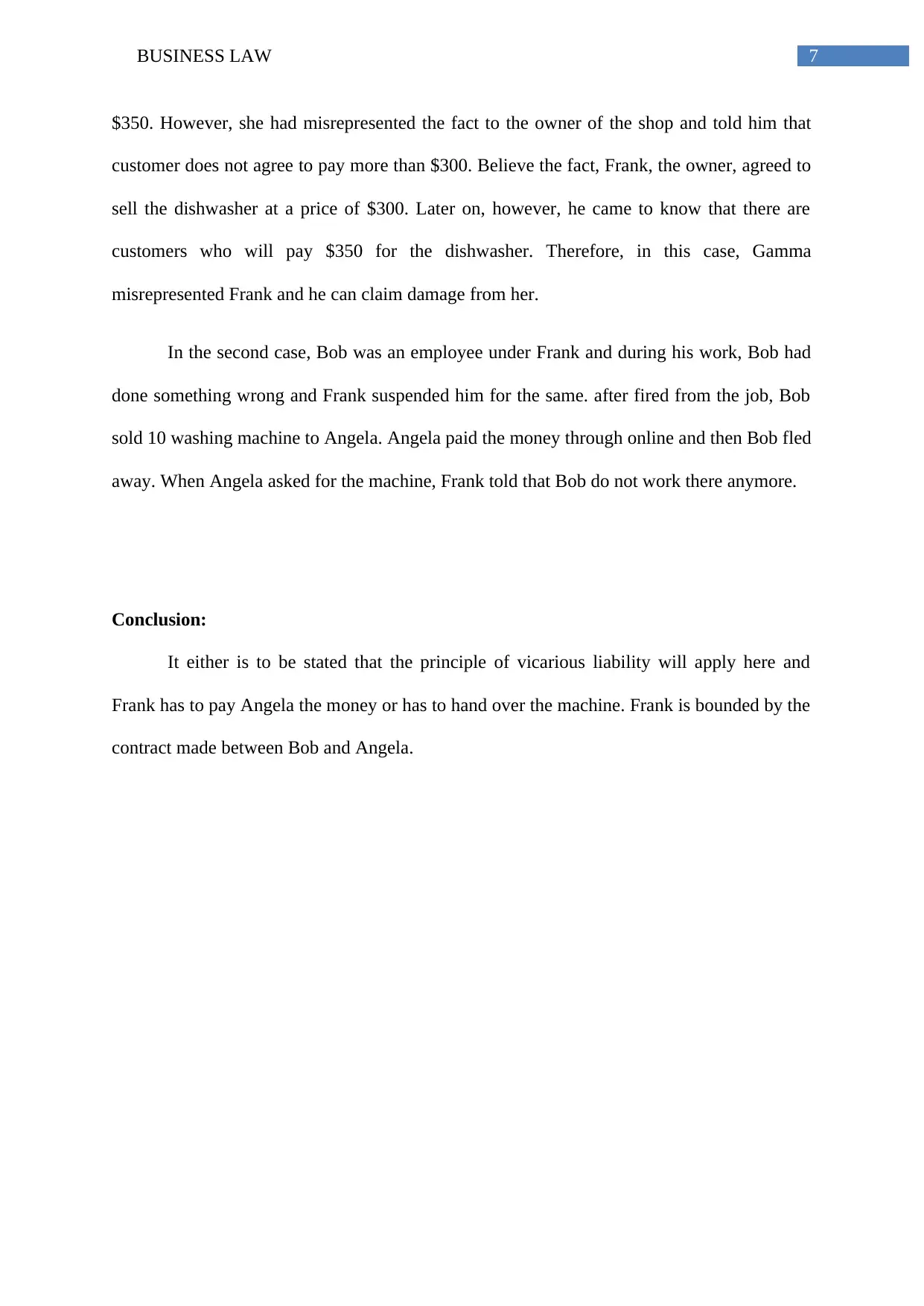
7BUSINESS LAW
$350. However, she had misrepresented the fact to the owner of the shop and told him that
customer does not agree to pay more than $300. Believe the fact, Frank, the owner, agreed to
sell the dishwasher at a price of $300. Later on, however, he came to know that there are
customers who will pay $350 for the dishwasher. Therefore, in this case, Gamma
misrepresented Frank and he can claim damage from her.
In the second case, Bob was an employee under Frank and during his work, Bob had
done something wrong and Frank suspended him for the same. after fired from the job, Bob
sold 10 washing machine to Angela. Angela paid the money through online and then Bob fled
away. When Angela asked for the machine, Frank told that Bob do not work there anymore.
Conclusion:
It either is to be stated that the principle of vicarious liability will apply here and
Frank has to pay Angela the money or has to hand over the machine. Frank is bounded by the
contract made between Bob and Angela.
$350. However, she had misrepresented the fact to the owner of the shop and told him that
customer does not agree to pay more than $300. Believe the fact, Frank, the owner, agreed to
sell the dishwasher at a price of $300. Later on, however, he came to know that there are
customers who will pay $350 for the dishwasher. Therefore, in this case, Gamma
misrepresented Frank and he can claim damage from her.
In the second case, Bob was an employee under Frank and during his work, Bob had
done something wrong and Frank suspended him for the same. after fired from the job, Bob
sold 10 washing machine to Angela. Angela paid the money through online and then Bob fled
away. When Angela asked for the machine, Frank told that Bob do not work there anymore.
Conclusion:
It either is to be stated that the principle of vicarious liability will apply here and
Frank has to pay Angela the money or has to hand over the machine. Frank is bounded by the
contract made between Bob and Angela.
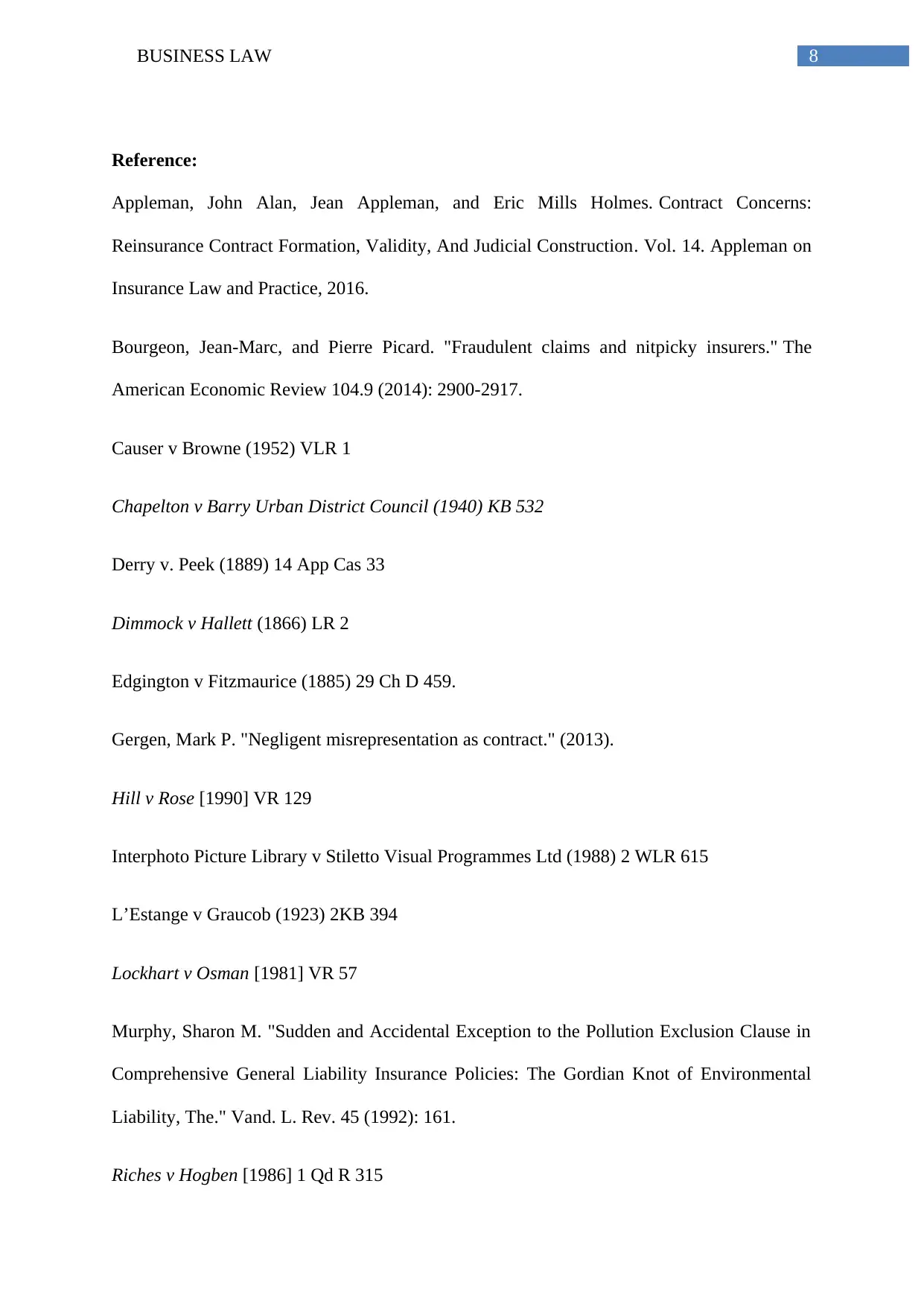
8BUSINESS LAW
Reference:
Appleman, John Alan, Jean Appleman, and Eric Mills Holmes. Contract Concerns:
Reinsurance Contract Formation, Validity, And Judicial Construction. Vol. 14. Appleman on
Insurance Law and Practice, 2016.
Bourgeon, Jean-Marc, and Pierre Picard. "Fraudulent claims and nitpicky insurers." The
American Economic Review 104.9 (2014): 2900-2917.
Causer v Browne (1952) VLR 1
Chapelton v Barry Urban District Council (1940) KB 532
Derry v. Peek (1889) 14 App Cas 33
Dimmock v Hallett (1866) LR 2
Edgington v Fitzmaurice (1885) 29 Ch D 459.
Gergen, Mark P. "Negligent misrepresentation as contract." (2013).
Hill v Rose [1990] VR 129
Interphoto Picture Library v Stiletto Visual Programmes Ltd (1988) 2 WLR 615
L’Estange v Graucob (1923) 2KB 394
Lockhart v Osman [1981] VR 57
Murphy, Sharon M. "Sudden and Accidental Exception to the Pollution Exclusion Clause in
Comprehensive General Liability Insurance Policies: The Gordian Knot of Environmental
Liability, The." Vand. L. Rev. 45 (1992): 161.
Riches v Hogben [1986] 1 Qd R 315
Reference:
Appleman, John Alan, Jean Appleman, and Eric Mills Holmes. Contract Concerns:
Reinsurance Contract Formation, Validity, And Judicial Construction. Vol. 14. Appleman on
Insurance Law and Practice, 2016.
Bourgeon, Jean-Marc, and Pierre Picard. "Fraudulent claims and nitpicky insurers." The
American Economic Review 104.9 (2014): 2900-2917.
Causer v Browne (1952) VLR 1
Chapelton v Barry Urban District Council (1940) KB 532
Derry v. Peek (1889) 14 App Cas 33
Dimmock v Hallett (1866) LR 2
Edgington v Fitzmaurice (1885) 29 Ch D 459.
Gergen, Mark P. "Negligent misrepresentation as contract." (2013).
Hill v Rose [1990] VR 129
Interphoto Picture Library v Stiletto Visual Programmes Ltd (1988) 2 WLR 615
L’Estange v Graucob (1923) 2KB 394
Lockhart v Osman [1981] VR 57
Murphy, Sharon M. "Sudden and Accidental Exception to the Pollution Exclusion Clause in
Comprehensive General Liability Insurance Policies: The Gordian Knot of Environmental
Liability, The." Vand. L. Rev. 45 (1992): 161.
Riches v Hogben [1986] 1 Qd R 315
⊘ This is a preview!⊘
Do you want full access?
Subscribe today to unlock all pages.

Trusted by 1+ million students worldwide
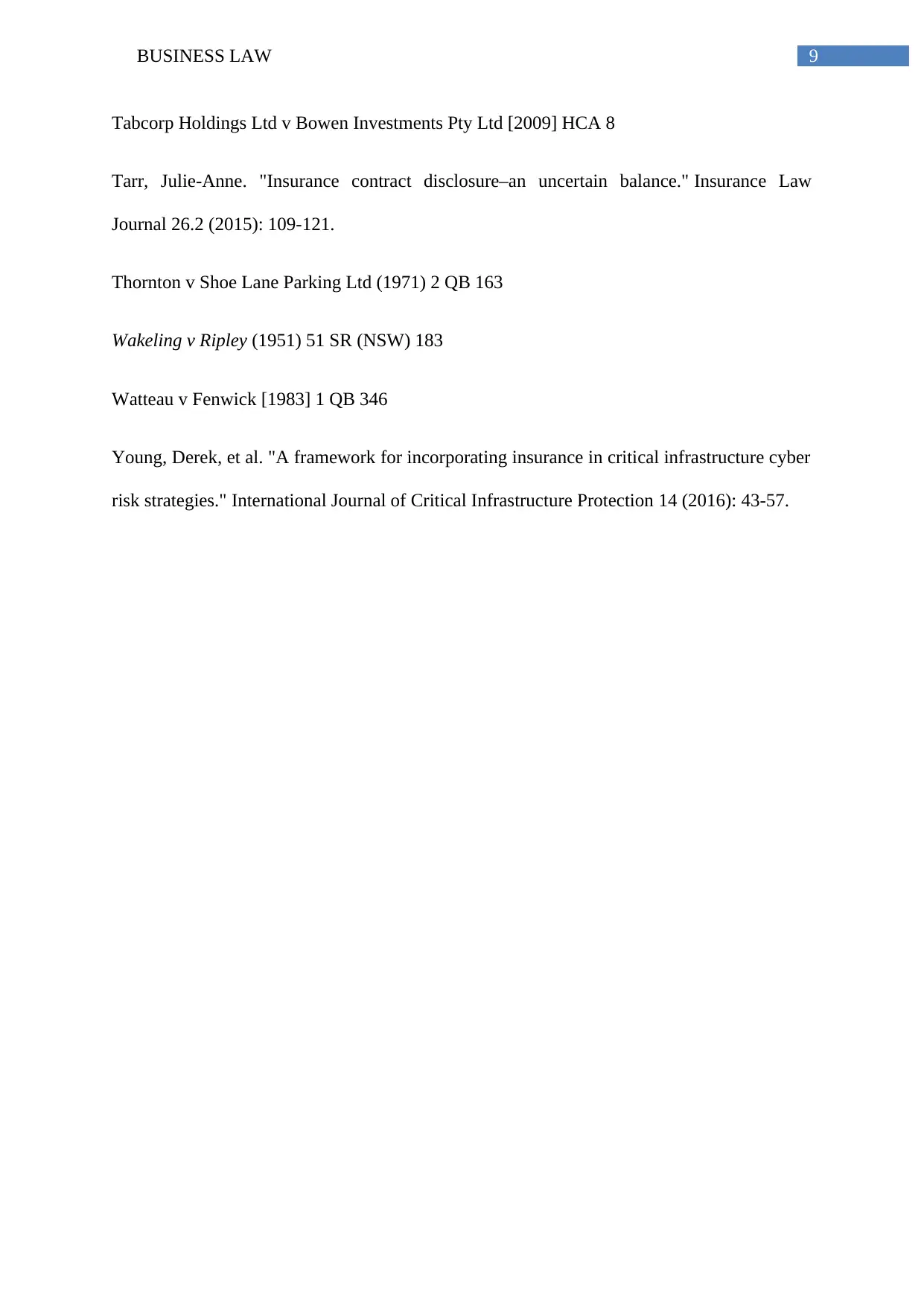
9BUSINESS LAW
Tabcorp Holdings Ltd v Bowen Investments Pty Ltd [2009] HCA 8
Tarr, Julie-Anne. "Insurance contract disclosure–an uncertain balance." Insurance Law
Journal 26.2 (2015): 109-121.
Thornton v Shoe Lane Parking Ltd (1971) 2 QB 163
Wakeling v Ripley (1951) 51 SR (NSW) 183
Watteau v Fenwick [1983] 1 QB 346
Young, Derek, et al. "A framework for incorporating insurance in critical infrastructure cyber
risk strategies." International Journal of Critical Infrastructure Protection 14 (2016): 43-57.
Tabcorp Holdings Ltd v Bowen Investments Pty Ltd [2009] HCA 8
Tarr, Julie-Anne. "Insurance contract disclosure–an uncertain balance." Insurance Law
Journal 26.2 (2015): 109-121.
Thornton v Shoe Lane Parking Ltd (1971) 2 QB 163
Wakeling v Ripley (1951) 51 SR (NSW) 183
Watteau v Fenwick [1983] 1 QB 346
Young, Derek, et al. "A framework for incorporating insurance in critical infrastructure cyber
risk strategies." International Journal of Critical Infrastructure Protection 14 (2016): 43-57.
1 out of 10
Related Documents
Your All-in-One AI-Powered Toolkit for Academic Success.
+13062052269
info@desklib.com
Available 24*7 on WhatsApp / Email
![[object Object]](/_next/static/media/star-bottom.7253800d.svg)
Unlock your academic potential
Copyright © 2020–2025 A2Z Services. All Rights Reserved. Developed and managed by ZUCOL.





